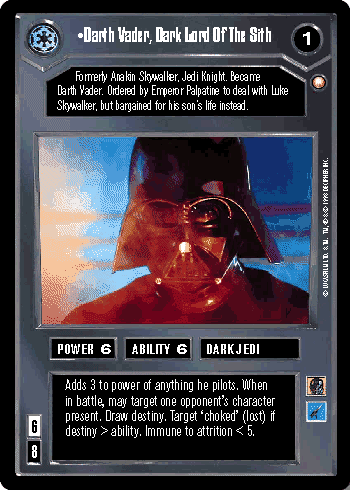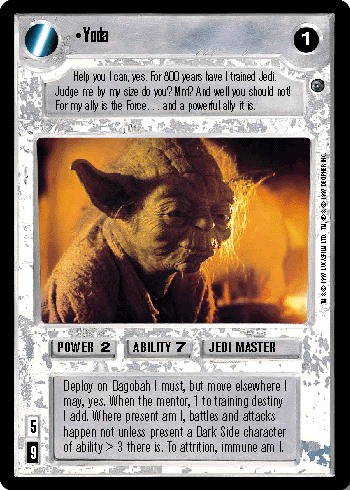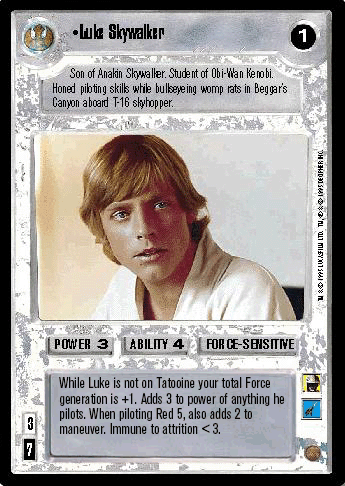“Imperial Walkers spotted on the North Ridge! Imperial Walkers spotted on the North Ridge!” The Rebels scramble to their snowspeeders and trenches – they have to defend Echo Base so the transports can get away. The Walkers make slowly make their way, bombarding the shield and engaging with the snowspeeders. But, you see, this isn’t the version of the Battle of Hoth you’re familiar with. In this version, the Rebels defeat the initial assault by the Imperial forces, so a long and bitter standoff ensues. Hoth is blockaded by the Imperial fleet, and Echo base is constantly fighting off against incursion. In the Star Wars Customizable Card Game, released by Decipher in 1995, you get to play out your own Episode of Star Wars.
Star Wars was originally released during the CCG boom of the 1990s. The original set covered the first two acts of A New Hope. Each expansion after that covered roughly one third of one movie – A New Hope covering the last third of A New Hope, Hoth covering the Battle of Hoth, etc. etc. The game was incredibly popular when in production, and was consistently the second best selling CCG, and occasionally even out-selling Magic. In 2001 Lucasfilm did not renew the licenced to Decipher, and the game ceased production.
Interestingly, the game is still alive in a virtual scene. The Star Wars CCG Player’s Committee retains control over the mechanics of the game, and regularly produces “virtual cards.” These cards, released as PDF expansions, ‘overlay’ existing cards, giving new text to already existing cards. The game enjoys a strong online community, and still sees play at major gaming conventions.
 There are two sides to the Star Wars CCG, and, yes, you’ve already guessed them – Light and Dark. Each player makes a 60 card deck comprised of only cards from the Light or Dark. The goal of the game is to run your opponent out of cards – to deplete their Life Force. The game is primarily played out at locations: systems or sites on planets. If you have units at a location and your opponent doesn’t, you can drain them of their Life Force on your turn. If they do have units there, you can battle them – losing a battle frequently causes you to lose Life Force. Most of the game played out in battles, as they are the best opportunity to ding your opponent of Force
There are two sides to the Star Wars CCG, and, yes, you’ve already guessed them – Light and Dark. Each player makes a 60 card deck comprised of only cards from the Light or Dark. The goal of the game is to run your opponent out of cards – to deplete their Life Force. The game is primarily played out at locations: systems or sites on planets. If you have units at a location and your opponent doesn’t, you can drain them of their Life Force on your turn. If they do have units there, you can battle them – losing a battle frequently causes you to lose Life Force. Most of the game played out in battles, as they are the best opportunity to ding your opponent of Force
At the start of your turn, you’ll generate force to use that turn, based on the number of Force icons on your side – locations provide you with Force icons. Force is generated by counting cards off the top of your deck, one at a time, to put in your ‘Force pile.’ You spend these cards, placing them one at a time, in your ‘used pile,’ to deploy characters, starships, weapons, equipment, and to play table-wide effects and interrupts. At the end of your turn, your used pile cycles back under your draw deck. On your turn, you’ll deploy your resources, check to see if you control locations, battle your opponent, and move your characters and ships around the board. When you lose Force as a result of a battle (or other loss), you can discard cards from your hand, deck, Force, or used pile. The player who runs out of cards first loses.
The game made a number of innovations to customizable card games. It was one of the first, and remains to be, one of the only asymmetrical card games. The Light and Dark side had different cards, and different strategies. The game did a very good job of capturing the feel of Star Wars – The Light has multiple ways of getting Force back after it has been lost, and the Dark has mechanisms for burning your own Force for damaging effects.
The game also used a “destiny” system. Each card has a destiny value in the upper right hand corner of the card, ranging from 0 – 7. Destiny draws were used to increase strength in battle, see if particular card effects worked or not, and fire weapons, among many other effects. Generally, the more rare, and better the card, the lower the destiny value. This meant that deck construction had an extra level to it – you wanted to make sure that you packed a few high-destiny card to add to battle damage. It also meant that skilled players were able to effectively count cards – with the cycling of cards between the deck, Force pile, and used pile, very skilled players could know what their destiny draw would be, before they drew it.
 The game didn’t take itself too seriously – there were hidden jokes throughout the entire cardset. Yoda’s card was printed in Yoda-Speak. The card depicting Luke’s headstand from Empire was printed upside down. The card “Hindsight” needed a mirror to be read. There was a Campbell’s soup can hidden in Owen and Beru’s hut. So on and so on. It made scouring the art and flavour text of every new set fun, to try to find the jokes. It is also always nice find a game that doesn’t take itself too seriously.
The game didn’t take itself too seriously – there were hidden jokes throughout the entire cardset. Yoda’s card was printed in Yoda-Speak. The card depicting Luke’s headstand from Empire was printed upside down. The card “Hindsight” needed a mirror to be read. There was a Campbell’s soup can hidden in Owen and Beru’s hut. So on and so on. It made scouring the art and flavour text of every new set fun, to try to find the jokes. It is also always nice find a game that doesn’t take itself too seriously.
For the most part, the game play of Star Wars feels like playing out an adventure in the Star Wars universe, which is why I like it so much. You get to have climatic battles between the two sides, there are Stormtroopers, X-Wings, bounty hunters, and countless aliens. You can have Luke duel Darth Vader. You can freeze Han in carbonite.
There were a few limitations to play, though. I ceased playing around the time that a strategy around “inserting” card into your opponent’s deck became popular. This particular build was very light on characters and battling, and seemed to betray the thematic heart of the game. (It was later fixed, mostly, in subsequent expansions). It was also less than fun if you and your opponent had a mis-match in decks. For example, if I showed up with my super-awesome give all the main characters their cool gear and lock down Tatooine, and you showed up with your crushing Imperial space fleet deck…. well, we weren’t likely to interact all that much. I’ve found that in casual play, it makes a lot of sense to plan around this – a quick conversation of “shall we do space battle? Or land battle at Endor?” can make for a much more enjoyable and interactive experience. Lastly, each expansion tended to add a few new rules, meaning the game can be quite dizzying – to the point of overwhelming – for new players.
 I really like the Star Wars CCG. Yes, it can be finicky, and yes, it can run quite long. That said, it is a dynamic, interactive card game that really captures the feel of the intellectual property that it’s based on. CCGs based on previously existing properties have been very hit or miss, and this one certainly is a hit. If you ever find me at a gaming convention, I likely have a few decks of Star Wars kicking around, and I’d be very pleased to teach it to you.
I really like the Star Wars CCG. Yes, it can be finicky, and yes, it can run quite long. That said, it is a dynamic, interactive card game that really captures the feel of the intellectual property that it’s based on. CCGs based on previously existing properties have been very hit or miss, and this one certainly is a hit. If you ever find me at a gaming convention, I likely have a few decks of Star Wars kicking around, and I’d be very pleased to teach it to you.
It’s worth very briefly discussing the current existence of the game. As mentioned above, a Player’s Committee releases virtual expansions. Even if you have no intention of playing with the virtual expansions, this can be somewhat frustrating for new players. Every virtual card indicates with pre-existing card it covers up, which means that players must have the pre-existing card to use a virtual card. So? Well, this means that there is still, decades later, a very strong secondary market for Star Wars – players are still buying up product so they can use virtual cards. Getting into the game can be frustrating. Collecting the game, especially to the point of completion, can be frustrating, time consuming, and costly. I’m glad that the game is still ongoing and fresh for players, but it is a barrier to entry worth highlighting.
Can I still play The Star Wars CCG? You totally can. There is a strong secondary market for it on eBay, and I’ve seen it for sale at a number of conventions on the dealers’ floor. I would suggest starting with some Premier or Special Edition starter decks, and grabbing some expansion packs from your favourite part of your favourite Star Wars movie.
Who Should Play The Star Wars CCG? Star Wars fans who are looking for a good Star Wars experience. You should have patience for a broad and finicky rules set, though. It looks like Star Wars, it feels like Star Wars, and it doesn’t take itself too seriously.
Who Shouldn’t Play The Star Wars CCG? It may be obvious, but if you’re not a Star Wars fan, you’re not going to find much to love in this game. The learning curve can be high and steep, so if you mostly gravitate towards lighter games, this might not be the game for you.
Great article! Look into the story of one of the cards (Shawn Valdez). It’s an amazing back story to one of the cards.